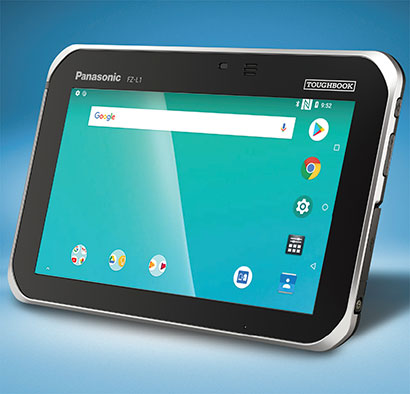|
Panasonic Toughbook FZ-L1
A slimmer, sleeker Toughbook — Panasonic's 7-inch FZ-L1 rugged Android tablet for today's connected workplace
(by Conrad H. Blickenstorfer)
On July 25, 2018, Panasonic announced the Toughbook FZ-L1, a slim and sleek 7-inch Android-based tablet designed for data collection in retail stores, warehouses field service, transportation and delivery or many other environments where a fragile consumer tablet just won't do.

Panasonic introduced the L1 tablet together with the 5-inch T1 handheld. The two new products share most tech specs, and both are part of Panasonic's initiative to bring the rugged reliability that has made Panasonic an industry leader in workplace mobility with a long succession of Toughbooks and Toughpods to a new generation of sleeker, slimmer devices. In essence, this is Toughbook 2.0, an adaptation to smaller, lighter devices of what the Toughbook brand has represented for well over two decades.
Toughbook 2.0 — sleek and sexy
The idea isn't entirely new. Over the years Panasonic has sold, with varied success, select products from its Japan domestic market "Let's Note" lineup as smaller and lighter additions/alternatives to the big and heavy "real" Toughbooks. This is different. With "the office" changing and technology an ever-present part of almost everyone's life, there's now a need for products that extend the reach of all that slim, sleek consumer tech onto the shop floor, into the factory, into vehicles, out onto the field, but in products that are purpose-built and sacrifice neither quality nor toughness.
So what does that look like in practice? The FZ-L1 definitely represents a visual and tactile departure from the traditional Toughbook design language of hefty, impressive magnesium housings with matte-silver powdercoat finish. Instead, there's now just enough of a hint of that in a sleeker, thinner, lighter design that channels the flush black glass, rounded corners, and elegant metal accents of trending consumer tech.
All of that makes for a cool looking and very compact 7.6 x 5.2 inch tablet that's just half an inch thick and weighs less than a pound. Despite being able to survive multiple 5-foot drops onto concrete, hundreds of tumbles from a meter and, of course, immunity to dust and liquids. Impressive. And needed when you use a tablet for work.
A look at the tech
For specs, the Toughbook FZ-L1 shares much with the FZ-T1 handheld. There's the Qualcomm "Snapdragon" 1.1GHz MSM8909 processor that includes four ARM Cortex-A7 CPU cores as well as 400MHz Adreno 304 graphics. There's 2GB RAM and 16GB eMMC mass storage plus what's in the micro SDXC card slot on the storage side (up to 64GB). For communication there's 801.11a/b/g/n and Class 1 Bluetooth v4.2. There is a contactless IC card reader (NFC), supporting Type A, B and Felica. And there is dedicated GNSS with 2 to 4 meter accuracy. The FZ-L1 has an 8mp camera in the back but, somewhat surprisingly, none in the front. Panasonic sells the FZ-L1 in two versions, one with WiFi only and one with data service on Verizon, AT&T and Panasonic's Panasonic P.180 for seamless global connectivity in over 180 countries via eSIM technology for Tier 1 LTE access.
What's different from the 5.0-inch FZ-T1 handheld is the size of the daylight-viewable display with 10-point capacitive multi-touch that is also glove- and rain-sensing. An optional passive pen is available. It's 7.0-inches diagonal here, with 1280 x 720 pixel resolution. That makes for 210 pixels per inch, which isn't retina class but sharp enough. There are two microphones and a speaker.
The availability of an optional industrial-grade scanner differentiates the Toughbook L1 from consumer phones and tablets that rely on their camera for an occasional scan. The L1 uses a SE4710 that incorporates intelligent imaging technology, sophisticated decoding algorithms and advanced focusing, optical and illumination systems for the high-performance scanning required to boost the productivity and efficiency of mobile workforce applications. For optimal ease of use, the integrated barcode reader is field-configurable for landscape or portrait modes.
Users of modern consumer tablets expect at least ten hours of battery life. The FZ-L1's battery only packs 12.2 watt-hours, but Panasonic claims the tablet lasts 12 hours "based on a standard enterprise user profile." Batteries are warm-swappable and easily replaced, though; a slider puts the device into standby mode for a quick exchange.
Android 8.1 "Oreo"
Which version of Android to use remains one of the more difficult choices handheld developers face, as version quickly change and it's not always easy to update. The Toughbook FZ-L1 comes with Android 8.1 "Oreo," which for now (July 2018) is the latest you can get. According to the Android Developers site, as of July 2018, Android Oreo versions 8.0 and 8.1 are used in about 12% of all Android devices. Compared to earlier versions of Android, Oreo boots quicker, allows minimizing of background overhead, adds auto-fill and smart text selection, has picture-in-picture, streamlines the user interface, and much more. Like the competition, Panasonic commits to several version updates for the FZ-L1 platform.
A promising proposition
The price for the basic Wi-Fi version of the Toughbook FZ-L1 starts at US$ 1,499, the exact same as the Toughbook FZ-T1 handheld. What about its competition? Surprisingly, there isn't all that much. With smartphones getting ever larger, most tablets have migrated up in size. Panasonic's sleek and handy Toughbook tablet may just be what a lot of enterprises have been looking for. -- Conrad H. Blickenstorfer, July 2018
|



